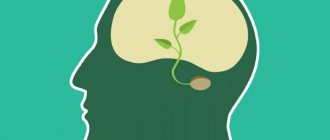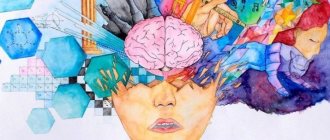Serotonin syndrome is the accumulation of too much serotonin in the body, which leads to a number of consequences. When a person takes a combination of drugs that contain serotonin (commonly prescribed antidepressants such as Zoloft, Lexapro, SSRIS and Effexor, SNRI), they are at high risk of developing serotonin syndrome.
Sometimes taking one drug to increase serotonin levels can also lead to serotonin syndrome in susceptible people. Before taking any medications, it is very important to discuss all medications you are taking with your doctor to avoid this potentially fatal condition.
general characteristics
Serotonin is an intermediate product of tryptophan metabolism.
Normally synthesized and stored in enterochromaffin cells of the intestine (more than 80% of the total serotonin content in the body), not synthesized, only stored/concentrated in circulating blood platelets, also localized (in significantly smaller quantities) in serotonergic neurons of the brain, approximately 2% tryptophan, which is consumed with food is converted into serotonin. Serotonin takes part in the contraction of smooth muscles and regulation of blood pressure; serotonin, which is released by platelets, plays an important role in platelet aggregation, serotonin is identified as a neurotransmitter in the central nervous system.
Excess serotonin (and its metabolite in the urine - 5-hydroxyindoleacetic acid) is detected when it is synthesized by carcinoid.
Carcinoid is a neuroendocrine tumor (derived from cells of the neuroendocrine system) that can transform malignantly and metastasize. Carcinoid can affect any organs that contain neuroendocrine cells, but is mainly diagnosed in the intestines (usually the small intestine, appendix), less often in the lungs, stomach, pancreas, common bile duct, and ovaries.
Carcinoid syndrome is a disease with symptoms caused by excessive secretion of serotonin (and other biologically active substances (bradykinin, prostaglandins) by the carcinoid).
Portrait of a patient with carcinoid syndrome: hot flashes (90%) - redness of the skin of the face and neck, rapid heartbeat, increased blood pressure, pain in the heart area, often with bronchospasm, diarrhea (70%) and cramping abdominal pain (40%) (nausea , vomiting), endocardial fibrosis with deposition of carcinoid plaques on the heart valves (40-45%). As the disease progresses, weight loss occurs; with further damage to the heart, a defect develops, most often in the right side (stenosis), and heart failure. Less common are telangiectasia (25%) and pellagra (5%). To the doctor: if you have a malignant disease, indicate the diagnosis in the referral. Medications and certain products (listed in the Interference, Interpretation, and Preparation Guidelines sections) should be discontinued 48 hours before and during sample collection, if clinically possible.
Panic disorders and the role of serotonin
Serotonin in the pathogenesis of panic disorders
A.V.Zberovsky, I.A.Bolbat
Abstract: The article analyzes the role of serotonin in the etiopathogenesis of panic disorders and puts forward a hypothesis about the leading role of the serotonergic system in the occurrence and development of panic disorders. A pathogenetic approach to the treatment of panic disorders is proposed.
Panic disorders are a common disease, the main manifestation of which is “panic attacks.” There is still no single concept of the pathogenesis and etiology of this disorder; they are presented in the form of a number of theories. The prevalence of panic disorders ranges from 0.6 to 2.7% of the population, with women suffering 2-3 times more often than men. The importance of finding a pathogenetic solution to the disease is due to the fact that, first of all, this disease affects the working population, and recovery rates do not exceed 70%. What makes this scientific and practical problem relevant.
According to the International Classification of Diseases (ICD-10) F41.0, panic disorder [episodic paroxysmal anxiety] is characterized by recurrent attacks of severe anxiety (panic), which are not limited to any particular situation or set of circumstances and, therefore, are unpredictable. We consider this condition as the main nosological unit, while at the same time a number of other diseases included in F40-F48 have a similar pathogenesis.
Currently, the leading model of the etiopathogenesis of panic disorder is the psychophysiological model. Where the main factor is internal stimuli for the occurrence of panic disorder. As a result, panic attacks occur due to the positive feedback between physical symptoms, their association with danger and the resulting anxiety reaction. At the same time, this theory does not imply an explanation of the neurophysiological basis for the emergence of both primary internal stimuli and the background processes that ensure the development of this condition, limiting itself only to a disorder of functional connections in the human brain. The lack of a unified theory of the occurrence of panic disorders prevents the creation of a generally accepted pathogenetic basis for treatment, which in turn creates significant difficulties in providing effective care to patients.
The connection between serotonin and panic disorders in the literature is usually recorded only as a phenomenon of a concomitant decrease in the concentration of serotonin in the brain against the background of panic disorders. The primacy of dysfunction of the serotonergic system as the cause of the onset and development of panic disorders has not been adequately addressed in the literature. Meanwhile, the experience of practical work with patients suffering from panic disorders allowed us to formulate a hypothesis about the leading role of serotonin in the pathogenesis of the formation of panic disorders. The hypothesis is that the primary cause of a number of pathological conditions, including panic disorders, is a disruption of the functioning of serotonin (5-HT) receptors. This may manifest itself as genetic polymorphisms in 5-HT neurotransmission at the 5-HT2A receptor and 5-HT1A. Confirmation of the high role of the hereditary factor is the high concordance in identical twins, with rates up to 50 percent of cases. In addition, the gender specificity of panic disorders is confirmed, since in men the mechanism of serotonin receptors is much more stable. Indirect confirmation of our hypothesis of disruption of synaptic processes is the success of pharmacotherapy using selective serotonin reuptake inhibitors acting on serotonin receptors. The hypothesis was confirmed, among other things, by dynamic studies conducted using computed tomography, which proved the connection between panic disorders and the concentration of serotonin in the brain.
The serotonergic system of the brain is mainly concentrated in the form of neurons in the nuclei of the central gray matter, the raphe of the brainstem, the midbrain, as well as a network of axons reaching many structures of the brain and spinal cord. The experiment confirmed the influence of serotonin receptors, the release of norepinephrine and dopamine, HT2C receptors affect mood, anxiety, sexual functions, appetite, sleep, and the functioning of the cardiovascular system.
Serotonin synthesized by a neuron enters vesicles, from where it enters the synaptic cleft, participating in impulse transmission. At the same time, part of it comes back, and part is destroyed by monoamine oxidase; these processes are successfully used in the pharmacotherapy of panic disorders. As a hormone, serotonin takes part in blood coagulation processes, affects the tone and permeability of vascular walls, enhances peristalsis in the gastrointestinal tract, and also affects the functioning of the pancreas, and affects the activity of the genital organs.
The process of serotonin formation is associated with the essential amino acid tryptophan, which is its precursor. At the same time, 95% of tryptophan is metabolized in the liver via the kinourenine pathway, as a result of which it no longer takes part in the synthesis of serotonin. In total, the body spends no more than 1% of tryptophan supplied with food for the synthesis of serotonin. The enzyme that mediates the conversion of tryptophan to N-formylkynourenine, tryptophan-2,3-dioxygenase (TDO), determines the concentration of available tryptophan in the blood, thereby increasing or decreasing the possibility of serotonin synthesis. In turn, in a neuron, serotonin synthesis occurs in two stages. First, L-tryptophan is hydroxylated to L-5-hydroxytryptophan, and then serotonin is synthesized. Moreover, the enzyme tryptophan hydroxylase (TPH), acting at the initial stage, limits the biosynthesis of serotonin.
Thus, against the background of dysfunction of 5-HT receptors, a person develops chronic stress, which is on a par with depression and anxiety. The reaction to stress is, first of all, the work of the nervous system, which triggers mechanisms that ensure survival in an extreme situation. If we talk about the internal regulatory reactions of the body, then it is necessary first of all to talk about stress hormones. As soon as the situation is assessed as critical in the neocortex (cerebral cortex), signals are immediately sent through feedback channels to the limbic system, which, being a more ancient part of the brain from a phylogenetic point of view, triggers response mechanisms, including through the hypothalamus connecting the endocrine system. The very first result of the neocortical-limbic interaction will be emotional arousal.
At the somatic level, the first and fastest reaction will be provided by the sympathetic department of the peripheral nervous system, transmitting nerve impulses directly from the central nervous system to nerve endings located in organs and tissues. Nerve impulses also reach the adrenal medulla, resulting in the release of excess adrenaline and norepinephrine into the blood, the main players in the “fight-flight” reaction. A little later, the endocrine system is activated, ensuring the duration and strength of the stress reaction. Activation of the hypothalamic-pituitary system releases a large amount of hormones (cortisone, corticosterone, etc.) providing adrenocortical, somototropic and thyroid reactions. The body’s reaction to the release of these hormones will be everything listed above: a rise in blood pressure, an increase in the strength and frequency of heart contractions, dilation of the bronchi, changes in blood composition, and so on. At the level of the brain, activation of central regulatory mechanisms occurs through the synthesis and release in the brain of such mediators as GABA, dopamine, serotonin, glycine, opioid peptides, etc. There is an increase in the metabolism of serotonin in the brain - in the hypothalamus, locus coeruleus - in areas closely associated with the limbic system. The task of serotonin is to limit the excitation of adrenergic centers, performing the task of limiting the stress reaction.
After the stress response enters the exhaustion stage, there is a decrease in serotonin production in the brain. At this moment, against the background of dysfunction of serotonin (5-HT) receptors, a disorder of functional connections in the human brain develops, which results in psycho-emotional symptoms developing against the background of autonomic disorders, including panic disorders. Violation of functional connections is expressed in the formation of dominant centers that cause excitation or depression, both in the functions of higher nervous activity and in the regulatory centers of the brain of the autonomic nervous system.
In the case of a “panic attack” scenario, a person experiences an attack of dizziness, tachycardia, shortness of breath, clouding of consciousness, and so on. A person becomes frightened by his sudden state, to which his body releases an additional portion of stress hormones (adrenaline, cortisol, etc.) into the blood, which will only intensify the symptoms, which will lead to even greater fear. The circle closed, and the panic attack began to develop and intensify, resulting in a vicious circle of “panic attack.” The development of events according to such a scenario corresponds to the development of a conditioned reflex, which was brilliantly described by I.P. Pavlov at the end of the 19th century. At the same time, in the brain, according to the dominant principle, a temporary reflex connection is formed, causing an unconditional reaction. For a person, one episode of panic disorder may be enough for a reflex connection to form in the brain that causes an attack under certain conditions. As a result, the vicious circle of panic disorder closes.
Thus, in our opinion, the cause of the conditions associated with panic disorders lies in the mismatched work primarily of the serotonin receptors of the central nervous system, and it is the severity of the resulting condition that determines the presence of accompanying symptoms and determines the amount of psychotherapeutic or psychological assistance, as well as the need to use certain medications.
Accordingly, the pathogenetic approach in the treatment of panic disorders should be the normalization of the serotonergic system of the brain and the elimination of the formed pathological functional connections in the neural environment of the brain.
Treatment can be divided into three parts: medication, psychotherapy, and a change in the patient’s lifestyle that will ensure the harmonious functioning of the serotonin system of the brain. The volume of treatment provided and the range of drugs used depend on the severity of the patient’s condition, for each decision is made individually.
Drug treatment includes:
- main pathogenetic, by influencing the functioning of brain synapses sensitive to serotonin, with the help of antidepressants that have an effect on serotonin receptors, selective serotonin reuptake inhibitors;
— relief of an acute condition, including relief of a panic attack, with the help of tranquilizers of the benzodiazepine group, relieving the excitation of foci of pathological dominant and breaking pathological reflex connections;
- in severe cases, antipsychotics can be used, which have a more powerful effect in terms of suppressing pathological dominant centers.
This article does not claim to be scientifically complete, but rather draws attention to the significance of the problem of the lack of a unified concept of the etiopathogenesis of panic disorders, and an invitation to a scientific discussion on this topic that will take on a practice-oriented orientation and will help improve the effectiveness of treatment of the corresponding disorders.
If you need psychological support in overcoming panic attacks and depression, I will be happy to give advice from a psychologist in a personal or online consultation (via Skype, Viber, WhatsApp or phone). My working conditions are described on the website www.zberovski.ru.
Sincerely, psychologist, Doctor of Science, Professor Andrey Zberovsky.
Sign up for a personal or online consultation by phone: +79266335200, +79029905168.
Clinical relevance
1. Study of 5-HIAA in urine per day (if clinically necessary, preferably twice on different days) with simultaneous study of the level of Serotonin and Chromogranin A in the blood is a reliable diagnosis of carcinoid. 2. For a joint assessment with the above-mentioned markers, it is recommended to examine the level of Neuroenolase (increased levels in 30-50% of patients with neuroendocrine tumors, especially in poorly differentiated tumors) and NT-proBNP (a significant increase in levels is a characteristic marker of carcinoid heart disease).
Causes
Serotonin syndrome most often occurs when two serotonin-related drugs are combined, although in some cases taking one drug that increases serotonin levels can cause this condition in some people.
For example, serotonin syndrome can occur if antidepressants are combined with opioid medications.
What medications cause serotonin syndrome?
Some medications and supplements that may cause serotonin syndrome when taken together or in high doses include the following:
- Selective serotonin repeat inhibitors: antidepressants such as citalopram (Celexa), fluoxetine (Prozac), paroxetine (Paxil), and sertraline (Zoloft).
- Serotonin norepinephrine repeat inhibitors (SNRIs), antidepressants such as trazodone, duloxetine (Cymbalta), and venlafaxine (Effexor).
- Tricyclic antidepressants such as amitriptyline and nortriptyline (Pamelor)
- Antimigraine drugs
- Pain medications: Opioid medications including codeine (Tylenol with codeine), fentanyl (Durage), hydrocodone meperidine (Demerol), oxycodone (OxyContin, Percocet, Percodan), and tramadol (Ultra).
- Lithium
- Street drugs: LSD, cocaine, ecstasy and amphetamines.
- Anti-nausea medications
- Cough and cold medicines
- Herbal Supplements: St. John's wort, ginseng and nutmeg.
- Cannabinoids can also affect serotonin.
Is Serotonin Syndrome Deadly?
If you don't seek medical help when serotonin levels become too high, severe serotonin syndrome can lead to unconsciousness and death. Intentional overdose of serotonin using antidepressants is one of the cases where serotonin syndrome can be fatal without prompt medical treatment.
Can Serotonin Syndrome Be Reversed?
Symptoms of serotonin syndrome usually disappear when you stop taking the medications that cause the symptoms. Fortunately, there are generally no long-term or lasting complications of serotonin syndrome, although you should be aware to avoid serotonin syndrome in the future. Talk to your doctor about prevention, especially if you are taking multiple medications that contain serotonin.
Patient preparation rules
venous blood
Standard preparation conditions (unless otherwise determined by the doctor):
Stop taking selective serotonin reuptake inhibitors 2 days before. Do not eat foods that increase serotonin levels: pineapple, eggplant, avocado, bananas, currants, kiwi, melon, plums, peaches, chocolate, gooseberries, tomatoes, walnuts, shellfish, vanillin, caffeine. For 8 hours, withstand fasting, eliminate fatty foods. You can drink water.
You can add this study to your cart on this page
Symptoms of excess serotonin
If you start taking serotonin-related drugs, increase your dosage, or start taking other drugs in combination with the drug you are already taking and too much serotonin builds up within a few hours, you will feel its effects.
Symptoms can range from mild to severe and depend on the level of serotonin in your body. At best, the signs and symptoms of serotonin are unpleasant; at worst, they can cause extreme anxiety and require intensive treatment.
The following symptoms are signs that you are experiencing serotonin syndrome:
- headache;
- shiver;
- goosebumps;
- heavy sweating;
- fearlessness;
- excitement;
- dilated pupils;
- confusion;
- diarrhea;
- fast pulse;
- high blood pressure;
- muscle stiffness;
- loss of muscle coordination, muscles twitch.
If you experience these symptoms, contact your doctor as soon as possible to discuss the best course of action.
However, severe serotonin syndrome can be life-threatening, and if you experience any of the symptoms listed below, you should seek emergency medical help immediately:
- Irregular heartbeat
- High temperature (>103 F/40 C)
- Seizures
- Unconsciousness
How long does serotonin syndrome last?
The duration of serotonin syndrome depends on the level of serotonin in the body. In cases where serotonin syndrome is present only in a mild form, symptoms may be relieved within 24 hours of stopping the serotonin-inducing drug. However, some antidepressants may take longer to cause symptoms because serotonin levels may take weeks to return to normal.
How common is serotonin syndrome?
According to the American Association of Poison Control Centers, in 2004, 8,187 people were diagnosed with serotonin toxicity as a result of using selective serotonin reuptake inhibitors (SSRIs). Of these, 103 people died.
However, given that statistics on serotonin syndrome are limited, they are likely to be much more common than the data suggests, as those who suffer from mild to moderate serotonin toxicity are often undiagnosed or unreported.
Interpretation:
- 1. consumption of foods that increase serotonin levels (pineapple, eggplant, avocado, bananas, currants, kiwi, melon, plums, peaches, chocolate, gooseberries, tomatoes, walnuts, shellfish), as well as vanillin, caffeine 2. Hypersecretion - carcinoid tumors of the gastrointestinal tract and pancreas; tumors causing atypical carcinoid syndrome (small cell (oat cell) bronchial cancer, medullary thyroid cancer) 3. slight increase: dumping syndromes, acute intestinal obstruction, fibrocystic degeneration, acute myocardial infarction, non-tropical sprue, headache, schizophrenia, hypertension , Huntington's disease, Duchenne muscular dystrophy and the initial stages of acute appendicitis
- Normalization of the marker level elevated before treatment reflects the positive effect of treatment. In patients with impaired renal function and patients on hemodialysis, significantly low levels are possible.
Sample result (PDF)
Why the syndrome may occur
Serotonin is called the “hormone of happiness”, since its safely high concentration gives a person a good mood and a state close to euphoria. If the level of the neurotransmitter decreases, the person feels depressed, apathetic and tired, and if necessary, a course of treatment is prescribed to increase the level of the hormone in the body.
The main cause of serotonin syndrome is the incorrect dosage of inhibitory antidepressants, which are aimed at increasing hormone levels. These medications trap serotonin in the body, controlling its concentration. The problem especially often arises if a person self-medicates or ignores the doctor’s recommendations in the hope that an increased dose of the drug will give a lasting and strong feeling of happiness.
In addition, the pathological condition can be caused by switching from one antidepressant to another, especially the third generation.
Also, an excess of neurotransmitter can occur during an overdose of narcotic substances. In an effort to increase the level of pleasure hormones and achieve a state of euphoria, some people try to use various psychotropic substances. However, in addition to the fact that addiction occurs and serotonin ceases to be produced without additional stimulation, overdoses often occur. They lead not only to pathologically high levels of the hormone, but also to more serious consequences.
It is noteworthy that the exact number of people who suffer from excess serotonin is unknown; medical statistics contain data on only a small part of such patients. This happens, firstly, because not all people with this condition go to see a doctor, and secondly, because not all specialists recognize the existing symptoms as a reason for making such a diagnosis.











